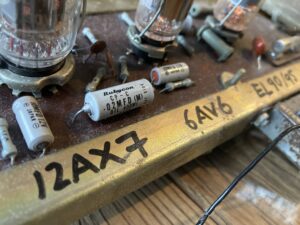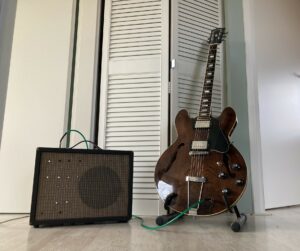Valentine’s Day
Interesting news on Valentine’s Day this year provided the perfect cue, to finally kick off a blog post again. Italian car maker Lancia unveiled its new electric “Ypsilon” model. It’s great to have Lancia, a brand steeped in the best Italian design tradition, back on the car market, after an absence of some 8 years. And of course, the subject of this blog also happens to be branded “Lancia”!
Some two and a half years ago, a band mate brought me this little vintage-looking amp for a checkup. He said that the amp only functioned intermittently, with the sound completely fading away, every now and then. The amp’s exterior was in a pretty sorry state, with no logo whatsoever, and a grille cloth full of ugly drill holes. However, the assertion that this was a tube amp sparked my interest and I figured that, based on its name, it might be Italian made. Always in for a challenge, I decided to have a look at it.

The chassis of the little Lancia. Nicely spot-welded, like that of the 1960’s Echolette Showstar from Germany.
Small, smaller smallest?
First of all, this Lancia was really a tiny amp. Our previous blog dealt with a 1963 FBT amp from Italy, with 2 6AQ5 output tubes or about 10W of power. The current amp featured only one 6AQ5, so half that power, at most… Now, from a pessimistic point of view, one could argue that it took Cosmic Ampworks twice the time to come up with a new blog, about an amp that has only half the power of the previous one, which was already tiny…
…but hey, growth isn’t everything and big isn’t always beautiful! Low power can be pretty cool for a practice amp. It’s easier to push into overdrive without getting the police on your doorstep. Also, sometimes it strikes me as a bit over the top to have a 50W of 100W tube amp running for hours, whilst mostly playing guitar at conversation volume. With a smaller practice amp, you could save electricity but have similar or even higher levels of fun! By the way, please rest assured that we have not become environmental fundamentalists. To draw a petrol-related parallel: sometimes a small car with a small engine can be more fun to drive than a heavier car with lots more power. It would be tempting here to compare the Lancia Delta HF Integrale, a world-famous 1980s rally car, with its close competitor of the day, the Audi Quattro. Unfortunately, it turns out that these cars were not that different in terms of weight and power… but maybe you have a better example?

The tube complement was conveniently written on the chassis by someone (EL90 is an equivalent to 6AQ5). Components, such as the Rubycon oil capacitors, are made in Japan.
Made in Japan!
As far as the amp is concerned, I decided to run a quick search on the interwebs. Soon enough, I found out that this wasn’t an Italian amp, but a Japanese one! Although the name was nowhere to be found on chassis, cabinet or speaker, the interwebs made clear that this amp was produced by Guyatone Japan, probably in the early 70’s. Was this some kind of budget model then, that they didn’t want to brand it under their own name? We’ll probably never know… but wait… we might still ask Guyatone! The brand is still active, based on their website. Guyatone is actually one of Japan’s oldest guitar manufacturers, having started production as far back as 1933. Its founder, Mr. Mitsuo Matsuki, specialized in woodwork and made his first lap steel guitar and amplifier in the 1930s. Hawaiian music was very popular in Japan back then! Later, they started producing for the export market and in the late 1950’s several well-known artists played Guyatone products. Among them, Hank Lee Marvin of The Shadows.

A peak at the back of the cabinet. Some Lancia amplifiers can be linked to the Guyatone brand, because they have a Guyatone/Tokyo Sound Co. branded speaker. This one has a NEC (Nippon Electric Company) speaker, however. It bears the pre-1992 NEC-logo, so it is probably the original one.
Inspired by the Lancia
Fixing the amp, after all, proved easy. Voltages in the amp fluctuated strongly, especially the plate voltage of its lone power tube. Upon closer examination, the plate resistor seemed somewhat blackish, and also produced tiny little sparks every now and then. That one was toast! Easy enough to replace it, and it seemed good practice to replace some of the original capacitors as well. Old oil capacitors may start to leak at some point. The amp was now ready to be returned to its rightful owner in good, playable condition. Although the exterior still looked as scruffy as before, this was a fun little amp to play, and one day, inspired by this little Lancia, Cosmic Ampworks might build its own single-ended 6AQ5 design!

The little Lancia, portrayed with a contemporary product from Japan: a 1974 Greco ES330-type hollow-body. The upper left corner of the amp’s grille cloth should proudly bear a “Lancia” logo, but apparently it went missing. Also, some ugly drill holes are obvious… it seems someone tried perhaps to screw something on to the grille at some point in history? On a positive note: that doesn’t affect the sound!